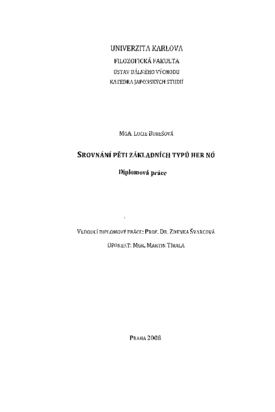Srovnání pěti základních typů her nó
Comparison of five principle types of the Noh plays
bakalářská práce (OBHÁJENO)

Zobrazit/
Trvalý odkaz
http://hdl.handle.net/20.500.11956/17086Identifikátory
SIS: 28066
Katalog UK: 990010356910106986
Kolekce
- Kvalifikační práce [24991]
Autor
Vedoucí práce
Oponent práce
Tirala, Martin
Fakulta / součást
Filozofická fakulta
Obor
Japonská studia
Katedra / ústav / klinika
Ústav Dálného východu
Datum obhajoby
9. 9. 2008
Nakladatel
Univerzita Karlova, Filozofická fakultaJazyk
Čeština
Známka
Výborně
Bakalářská diplomová práce Srovnání pěti základních typů her nó sleduje tradiční klasifikaci japonských her nó do pěti typů podle postavy, jakou představuje hlavní herec šite. Podle tohoto rozdělení analyzuje pět her ke každému typu: Curukame (Jeřáb a želva), Acumori, Hagoromo (Nebeské roucho), Seimaru a Funa Benkei (Benkei na lodi). K analýze je přistupováno spíše z pohledu performativního umění než z hlediska lingvistického, hlavním kritériem je dramatické rozvití hry podle systému džo-ha-kjú, k němuž přispívá charakteristika hlavní postavy. Autorka vychází z japonských originálních libret jókjoku, překladů scénářů do evropských jazyků i videoukázek divadelních představení.
The bachelor thesis Comparison of the Five Principle Types of the Noh Plays deals with the traditional classification of Japanese plays No according to the characteristic role the main actor shite performs. Following this classification it proceeds to the analysis of five plays: Tsurukame (Crane and Tortoise), Atsumori, Hagoromo (The Feather Mantle), Semimaru and Funa Benkei (Benkei on the Boat). The author's approach is based more on performance art theories than linguistics, the main criterion being the dramatic development of each play according to jo-ha-kyu system, considering characterization of the role during the play. The thesis is based on Japanese librettos yokyoku, script translations in to main European languages and video s of theatre performances.
